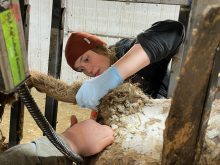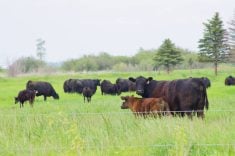Bovine viral diarrhea virus is a common infection that is often regarded as one of the most important infectious diseases in cattle.
An outbreak in Germany was recently described in the journal Heliyon, which highlighted the importance of biosecurity in preventing the spread of this devastating disease.
BVD virus is genetically diverse and readily mutates, which allows it to produce many different strains. These strains are grouped into two large categories: Type I and Type II.
North American diagnostic laboratories identify Type II viruses 39 percent of the time, but the strain isn’t identified as frequently in Europe.
Read Also

Feds propose overhaul of chronic wasting disease control program
Chronic Wasting disease control program getting updated by Canadian Food Inspection Agency with feedback encouraged from producers.
Several large BVD outbreaks that were particularly lethal have been related to the Type II virus in the past.
BVD virus can be spread from animal to animal through direct or indirect contact. People and machines such as livestock trucks and manure handling equipment can spread it from farm to farm.
BVD virus can also create persistently infected animals, which are the result of a cow becoming infected in early pregnancy and subsequently infecting the fetus.
The fetus’s immune system becomes tolerant to BVD virus and does not produce antibodies against it if it is infected at the right stage of gestation. The calf is then born persistently infected and becomes a living virus factory, which is often responsible for spreading the virus to other animals.
As a result, making sure that PI animals are not present in a herd is often an important part of any control program.
Germany had made BVD a notifiable disease in 2004, and many parts of Germany had begun a nation-wide control program in an attempt to eliminate the disease.
The control program focused on identifying persistently infected animals by testing and removing them from the population.
Vaccination for BVD was allowed as part of the control program but was not adopted widely by farmers and veterinarians. As a result, many herds had no antibodies to BVD virus and were highly susceptible to any introduction.
In November 2012, a dairy farmer observed sick cows with lower milk production, pneumonia symptoms, fever, diarrhea and sudden deaths in both cows and calves. Animals tended to die within two to three days after the onset of clinical signs.
Type II BVD virus was the cause, but unfortunately a diagnosis was not made until almost three months later. During that time, the virus spread to at least 20 farms in the region and even to some farms in the Netherlands.
This particular strain of Type II BVD virus was highly lethal and caused severe disease after infection occurred. Persistent infections were not common with this strain and were not identified with Germany’s control program.
Mortality varied from two to 31 percent of animals, although several farms had losses of up to 50 percent of calves younger than three months. Many of the operations were mixed farms with both dairy and beef animals affected.
An epidemiological investigation attempted to trace the outbreak and examine the connections between the affected farms.
One of the key components that allowed the outbreak to expand to such a large level was the fact that it went undiagnosed for almost three months before control measures could be put in place. This demonstrates the importance of using a diagnostic lab and local veterinarian when dealing with potential infectious disease issues.
Germany’s BVD control program was also focused on identifying persistently infected animals, which in this case were not common with this strain of the virus.
One of the most interesting aspects of the epidemiological investigation was the fact that many of the secondary outbreaks were caused not by the movement of animals but by contact with vehicles and people.
Movement of animals is often considered the primary risk factor for spreading an infectious disease from one farm to another, and it certainly played a role in this outbreak. However, when studying the connections between affected farms, the investigators concluded that farmers and veterinarians were the most likely sources of transmitting virus in secondary outbreaks followed by “trade contacts” and vehicle contacts.
This finding highlights the importance of simple biosecurity measures such as washing boots, changing coveralls between farms and cleaning and disinfecting vehicles and equipment.
North America’s hog industry has been wrestling with porcine epidemic diarrhea virus, which highlighted many similar issues in regard to biosecurity.
The German outbreak could have been prevented by an earlier diagnosis, simple biosecurity measures and the use of vaccination programs.
Veterinarians in Western Canada have been advocating the use of vaccines for BVD virus for many years to prevent persistent infections (by vaccinating breeding cows) and acute BVD infections. However, vaccines are only one part of a disease control program, and this outbreak demonstrates that simple biosecurity measures can play an important role in protecting the health of our cattle.
John Campbell is head of Large Animal Clinical Sciences at the University of Saskatchewan’s Western College of Veterinary Medicine.














